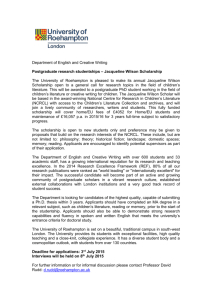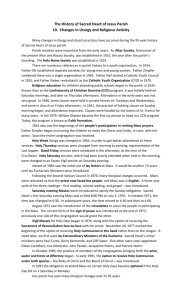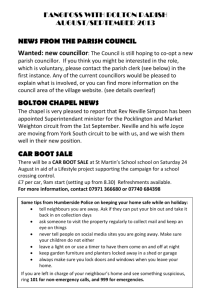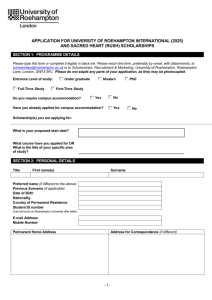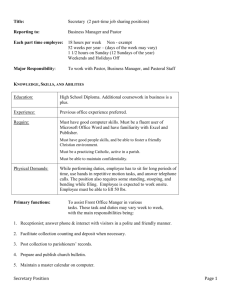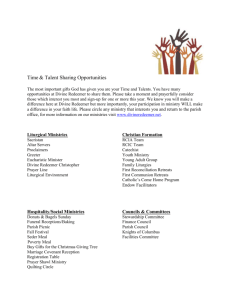CHURCH SCHOOLS - Roehampton Ecumenical Parish
advertisement
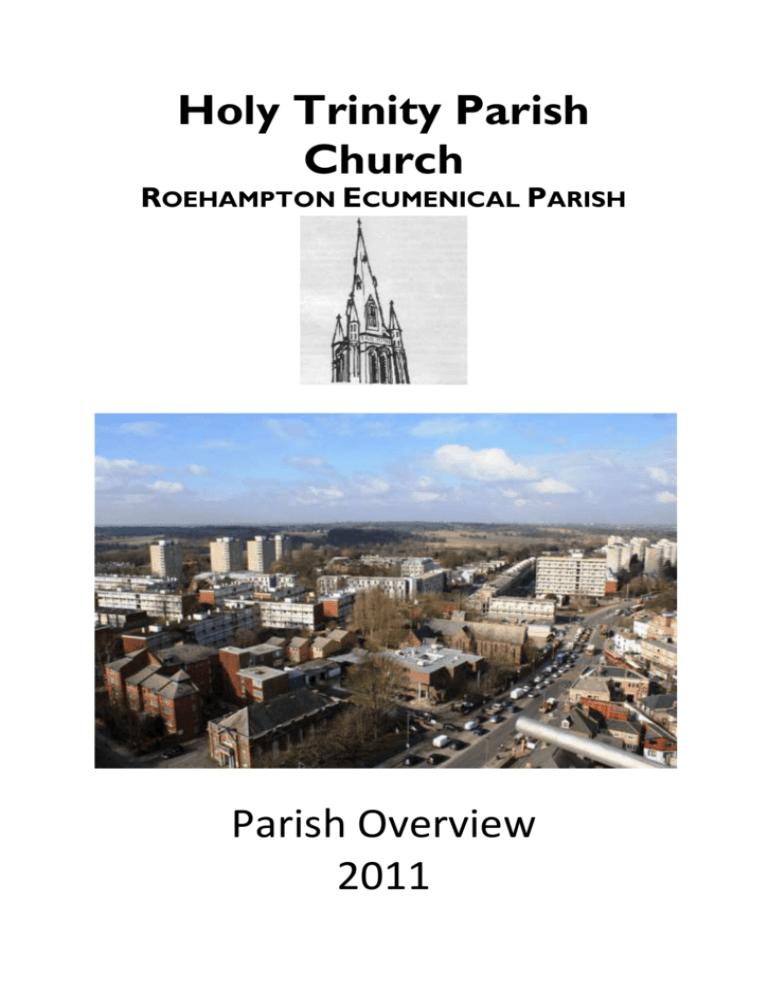
Holy Trinity Parish Church ROEHAMPTON ECUMENICAL PARISH Parish Overview 2011 BROAD DESCRIPTION OF THE PARISH AREA AND ITS DEMOGRAPHICS; NUMBERS RESIDENT IN THE PARISH/ BUSINESSES ETC Roehampton was originally an ordinary Surrey village until the Sixteenth Century when Henry VIII cleared the farmsteads to the west of the village, across from Beverly Brook, and evicted their tenants. This was to make way for the enclosure which became Richmond Park. From then until the post Second World War era, Roehampton was an immensely wealthy and very exclusive outer London retreat for the political elite of the country. Four Prime Ministers and one future King made their homes here. After the Second World War, the Roehampton council estates were put up in the grounds of the great mansions to house those made homeless or in temporary accommodation as a result of enemy bombing or slum clearance. The estates account for about 10,000 people. The rest of the parish is very similar to neighbouring parishes consisting pre-dominantly of middle class semidetached or detached houses and flat conversions. There is a great deal of building taking place at the moment with developments at the old Queen Mary’s Hospital site, the old nurses home at Arton Wilson House, and a number of other brown field sites for smaller-scale housing. These make up another 6,000 of the population. In terms of population there is the university to consider as well. About 3,000 students live on campus, with another 6,000 living around the local area. About half of these live in Roehampton in the old council accommodation, but refitted by private landlords who now pack in six to eight individuals in flats that were designed for three to five people. Many migrant labourers live in this accommodation also. Thus it is very difficult to give a precise figure for our population, but around 20,000 would not be far off the mark. The post war estates were a very successful piece of social engineering. Community spirit flourished: Scouts, Guides, the Boys Brigade, all had long waiting lists. Amateur dramatics and all sorts of associations thrived. However, a decline began to emerge in the early 1990s which has accelerated since. Tenants’ right to buy, and the obligation of local authorities to house the homeless, meant that there was a significant shift in the way in which housing was allocated. The flats bought by their tenants were eventually sold off to the private landlords mentioned above. Those flats still under local Authority control were allocated on the ‘points system’. The families with most points tended to be lone parent, two or more children, unemployed and usually a health problem with one or more members of the family. Over time this has had a devastating effect on the estates. We now have a highly atomised community with no role models, high unemployment and low expectations. The other group which scores high points are the families of asylum seekers. We now have a large Somali community and Sudanese community. Roehampton has the highest child deprivation, unemployment and ill health indices in Wandsworth Borough, and the lowest economic activity index. The only mass employer is ASDA, although Queen Mary’s Hospital does employ a few locals in service roles. ELECTORAL ROLL / MEMBERSHIP MAKEUP Total and ethnic breakdown White British 70%, African 25%, Others 5% Approximate age break-down Over 60yrs: 50%, 40yrs – 60yrs: 30%, 0-40yrs: 20% Agreed membership figures 60 – Electoral roll - 90 Average Sunday attendance in autumn 2010 – Communicants c50, Global: 70 Nos of baptisms, weddings and funerals in 2010 Baptisms: 20, Weddings :12, Funerals: 70 Easter and Christmas attendance and communions in 2010 Easter: Communicants – 60, Attendance – 80 Christmas: Communicants - 65, Attendance - 100 Theological outlook of Church members/Parish on a scale of 1 to 5 (1 Conservative 5 Liberal)? 3 This is a mid-point between two emphases. In terms of doctrine the congregation would see themselves as traditional/orthodox, taking a traditional line on the Resurrection, the Trinity, the Virgin Birth etc. There would be a non literalist approach to Scripture and a Liberal approach to Social Ethics. Social outlook of Church members / Parish on a scale of 1 to 5 (1 Conservative 5 Liberal)? 4 This is a guess. We are too disparate to have a consensual party political outlook. Also we have a number of members of the congregation who would have a conservative political outlook, but a much more liberal outlook in terms of individual rights. What presenting issues within Church life would most concern Church members? Paying the Quota Ecumenical Issues, particularly with regard to Anglican Methodist relations: strong desire to reach visible unity. Justice Issues: Race, Gender and Sexual Orientation Equality, Disability and Financial Inclusion What presenting issues in community / political / national life would most concern church members? Marginalisation of Estates as in Roehampton Concern for young people and access to housing Dementia and health issues amongst the elderly, particularly with regard to access to health services Attitude to women in ministry / women bishops and gay clergy Very much in favour of both. We have had a number of women clergy serve here, and both our most recent curates were gay. CHURCH BUILDINGS AND PLANT Holy Trinity Church used for religious services, concerts, bazaars and community meetings. Roehampton Parish Hall ‘The Cornerstone’ at present used by ‘Chapel Street Family Hub’ a Christian Social Enterprise, principally a Nursery School. But also occasionally used as a Wedding Reception or Celebration venue. Minstead Gardens Methodist Church/Hall used for religious services by a number of groups. Also used by Regenerate RISE, a charity for the housebound elderly, and by Regenerate.Com a young people’s Charity. Also used by other groups on an occasional basis. also Roehampton Church School adjacent to the Church available for use by the church and community groups. STAFFING One Vicar – paid, One Methodist Urban Missioner – paid, One Honourary Assistant Priest – unpaid One Organist/Director of Music – paid FUNERALS – who does them? The Vicar and Urban Missioner. Occasionally services are conducted by the Licensed Reader who is accredited. LAY INVOLVEMENT Lay members direct and organise concerts, bazaars and almost all our many social events. They also organise server rotas, cars to church rotas, readers’ rotas, coffee rotas, sidespersons’ rotas and everything musical. Also we have lay administrators of communion for church and home. CLERGY ORGANISATION The Vicar shares Sunday worship leadership with Keith Rowbottom, the Methodist Urban Missioner on about five occasions per quarter. The Vicar will be in the Methodist circuit about once a month, and will lead the rest of the worship by himself. It is hoped that Daniel Eshun, the University chaplain will be able to rejoin the team after a very serious illness. FOR HOLY TRINITY; WORKING IN PRACTICE OF ECUMENICAL PARISH This works very well contributing enormously to the combined ethos of the two churches. Constantly it throws into relief the particularity (and peculiarity) of Church of England practice. With regard to Holy Trinity, this means that we are able to retain our Anglo Catholic heritage along with a robust questioning of that heritage. This would be seen in our slightly anarchic modus vivendi with almost a suspicion for authority and its trappings. WEEKLY SERVICES Usual pattern / CW order Sundays: 10.00am Parish Eucharist (CW) 12.00noon Holy Communion (BCP) 3.00pm Afternoon Service at Methodist Ch Saints’ Days: occasional 6.00pm Holy Communion (CW) Daily: Morning Prayer at 7.15am Lent and Holy Week: special programme Sunday school Meets during 10.00am service in its own special Sunday School Corner in Church Lay involvement in reading, serving etc At each service we have lay administrators of communion, congregational readers and intercessors and servers. Every role open to the laity is taken on by a lay person. Music provision We have a permanent organist and extremely loyal choir. PATTERN OF WEEKLY ACTIVITIES AND SIGNIFICANT REGULAR ANNUAL EVENTS Morning Prayer is said virtually every day at 7.15am. We have a contemplative Prayer group which fortnightly at 2.00pm. Our Joint Church Council meets on a weekday evening once every two months. Its venue alternates between Holy Trinity and Minstead Gardens Methodist Church. Other meetings are held during the daytime and occur every two months. We hold about four concerts a year, with the next one taking place at Holy Trinity on February 13th: ‘Ceud Mile Failte’ a celebration of Celtic music and song. All are welcome. During Lent we have weekly devotional services and talks on spiritual or Lenten themes. We have a full Holy Week programme culminating in our Walk of Witness with the Methodist Church and St Joseph’s which then draws to a close with the full Triduum at St Jospeh’s. This has been very important in our ecumenical development, and sometimes we have significant numbers of people from all around London to take part in this unique event. REGULAR / SEASONAL STUDY OR HOUSE GROUPS As above CHRISTIAN INITIATION: BAPTISMAL POLICY/ADMISSION OF CHILDREN TO COMMUNION BEFORE CONFIRMATION PRACTICE/USUAL CONFIRMATION PRACTICE We have an open Baptismal policy, and we often have small baptismal services on Sunday afternoons as well as at the main services. We have had a mixture of policies in the area of children’s reception of communion, but currently children have to wait until they are confirmed before receiving the sacrament (unless they have been receiving at a previous church) Confirmation provides us with our most difficult practical issues as an ecumenical parish. Everyone who is confirmed here is confirmed into both the Church of England and the Methodist Church. The CofE confirms using bishops; in the Methodist Church it is the local minister who confirms. The main problem comes with Deanery confirmations where there needs to be some deft choreography. PCC AND COMMITTEE STRUCTURE / MEMBERSHIP NUMBERS/PATTERN OF MEETINGS Our main church council is the JCC – Joint Church Council, comprising the PCC and Methodist Church Council. This is our supreme decision making body. We have varying subcommittees depending on the priorities of the time. At present we are preoccupied with buildings and so our principal subcommittee is the Churchwarden’s Buildings Committee. We also have a Parish Hall Committee. YOUTH WORK AND CHILDREN’S WORK This is focussed on our Sunday School which is going through a period of transition. Up until recently our main recruitment vehicle has been the Church School. Since 1996 the proportion of indigenous children attending the School has been falling. It is now around 20%. The rest of the school comes from communities for whom English is a second language, and whose culture and religious background is very different. The school is now over 50% Muslim. (Church of England schools are very popular with Muslims because the parents do not want their children to attend ‘godless’ schools.) Of the rest, although Christian, the children usually attend their own ethnic minority churches – principally Nigerian. Our potential for recruitment from the school has dropped therefore by 75%. Most of our children are toddlers, and therefore need a different kind of managing. We have two dedicated teachers and some of the mums help out too. FINANCE Annual diocesan quota (and whether it is up-todate) Our Quota has just been halved from £38,000 to £19,000pa. We owe £26,000 from 2010. For several years now we have been Quota, way above what has been fair, and we have had to pay out from our capital assets which have all but been exhausted. Church giving income lettings income; investment income – FOR 2009 Our Spire Appeal has distorted our Giving Figures, but in general terms we raise about £35,000 from the congregation. Running costs Over and above Quota these are about £22,000 Reserves - What?????? QUINQUENNIAL SURVEY SUMMARY FINDINGS These were all to do with our Spire, and have all been fulfilled. CHURCH SCHOOLS; admissions policies; parish and clergy involvement / relationship with the churches etc We have one Church School – Roehampton Church School. The Vicar is Chair of Governors and does one assembly in church every week with help from the Urban Missioner. It has a complicated admissions policy targeting a) ‘looked after’ children, b) siblings, c) Anglican churchgoers, d) other churchgoers e) other faiths and then non church families all within our three parishes. RELATIONSHIP WITH LOCAL SCHOOLS / CARE HOMES / SHELTERED HOUSING / COMMUNITY GROUPS ETC Usually we have a couple of visits per term from classes belonging to the other schools in the parish: Heathmere, Alton, Ibstock Place and very occasionally from Granard. There is little involvement with Care Homes or sheltered housing, unless one of our members moves in. Usually we have a home communion visit, once a month, to Pocklington Court, the local home for the blind for a handful of residents. We have had a close involvement with the Heathside Centre for people with learning difficulties in the past, but that is due to close because of the Cuts. We hope to come to some arrangement with the members there to make use of either Minstead Gardens or Holy Trinity itself. There are two local semi-representative local amenity groups which each meet once every two months to which church members belong and both of which the Vicar is Chair: the Roehampton Forum and the Roehampton Partnership. The latter qualifies him to be a member of the Wandsworth Local Strategic Partnership, which has led him to be Chair of the Wandsworth Community Empowerment Network. As Vicar of the parish he is ex-officio a Governor of Whitelands College, Roehampton University. There has been a long involvement between Holy Trinity and Queen Mary’s Hospital over many decades. This continues with three members of the congregation who form part of the chaplaincy team at the hospital. The previous chaplain, Domini Lucas was a member of our fellowship. MISSION STATEMENT (IF ANY) We do not have one. Our broad emphasis, however, would be to create and maintain a quality of personal interaction: friendliness, respect, caring, honesty and good cheer, amongst the congregation which we would hope reflects the love of God as seen in Jesus. This might be called a ‘taster’ for the Kingdom of God. The emphasis then is to invite others into this sphere whereby they may be encouraged, challenged and embraced. A constant theme in our preaching and reflection is the utter difference in the values of the Kingdom compared to the spirit of the age. The path of the individual is the perennial negotiation between the demands of the World whilst being open to the call of the Other. MISSION PRIORITIES We want to find ways to make greater use of Holy Trinity building – opening it more often and inviting people in. In many ways it is our greatest evangelistic asset. RELATIONSHIP WITH OTHER CHURCHES We get on very well with each other and with St Joseph’s. We think that the new covenant for Churches Together in Putney and Roehampton offers wonderful opportunity for deeper friendship with more churches. WHAT ARE THE MAIN PROBLEMS FACING THE CLERGY? Without doubt, the major problem for the Vicar is the lack of secretarial help. Various ways of attempting to address this issue have been tried, but have come to nothing. Instead we have invested in a really fantastic printer which has done a lot of good.



